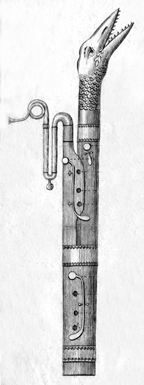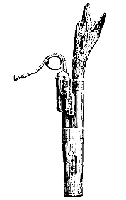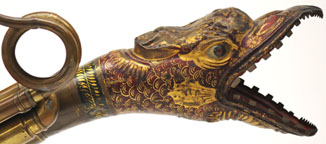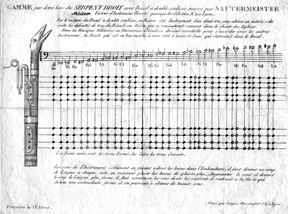
Instruments: Basson russe
under construction



The most picturesque type of bass horn, equaling the visual interest of the serpent d’église, is the so-called Russian bassoon, a military instrument often sporting a painted dragon’s head for its bell. The instrument, said to have been designed circa 1780, consists of four to five sections including butt and wing joints similar to the conventional bassoon, a conical bell column and dragon’s head, and either a single coiled or swan-shaped bocal. J. J. Regibo of Lille, France is attributed as the inventor of the basson russe, claiming that the instrument was stronger and easier to play than the serpent ordinaire.
The term Russian bassoon (basson russe) is thought to have been a linguistic evolution caused by the instrument’s use in the Prussian military band—an adaptation of “basson prusse.” The narrower bore dimensions of the basson russe, in comparison to other bass horns, permitted an expanded and clearer higher register, easily entering into the fourth octave. Yet, as Hector Berlioz may have penned the serpent’s greatest criticism, his assessment of the Russian bassoon proved nearly as damning when he stated in his Grand traite d’instrumentation et d’orchestration modernes that the instrument “could be withdrawn from the family of wind instruments . . . without the least damage to art.”



One important designation among the upright serpents is the configuration of finger holes for the lengthening of the air column. Using Mendelssohn's 1824 line drawing of the English bass horn (sent in a letter to his sister, Fanny), finger holes have been placed in order on the air column as a way to display their positioning for the basson russe.
C. Kridel
H. Macdonald, ed.: Berlioz’s Orchestration Treatise: A Translation and Commentary (Cambridge, 2002).
Piccolo Press : ITEA Historical Instrument Section : The Tigers Shout Band : Harmoniemusik : Links